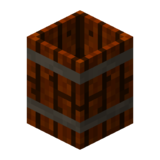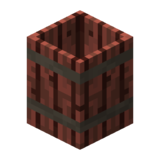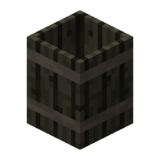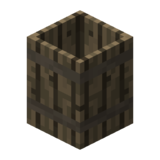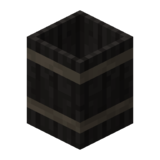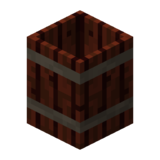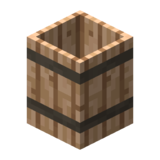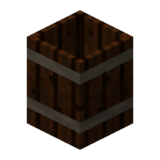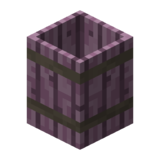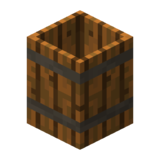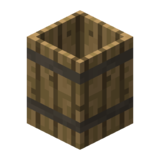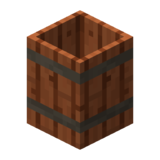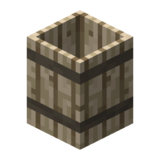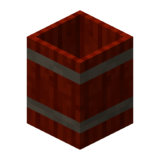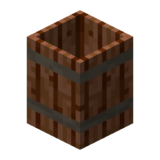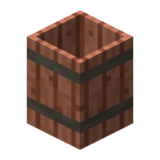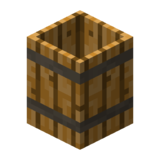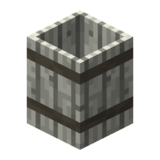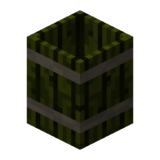Difference between revisions of "Barrel"
(added some infobox info) |
(Updates barrel recipes for alcohol and vinegar.) |
||
| Line 83: | Line 83: | ||
===Alcohol=== | ===Alcohol=== | ||
| − | Alcohol is created by adding | + | Alcohol is created by adding certain types of food to a fresh water barrel, and then sealing the barrel for 72 hours. It takes 2 food units per bucket, so 20 food units for a full barrel. |
| − | + | beer: barley flour | |
| + | |||
| + | cider: apple | ||
| + | |||
| + | rum: sugar | ||
| + | |||
| + | sake: rice flour | ||
| + | |||
| + | vodka: potato | ||
| + | |||
| + | whiskey: wheat flour | ||
| + | |||
| + | corn whiskey: cornmeal flour | ||
| + | |||
| + | rye whiskey: rye flour<ref>https://github.com/TerraFirmaCraft/TerraFirmaCraft/blob/0db85fb154f9602316aeb9655fa93124bf2cae94/src/main/java/net/dries007/tfc/types/DefaultRecipes.java#L107</ref> | ||
===Vinegar=== | ===Vinegar=== | ||
| − | + | Fruit added to a barrel of alcohol and sealed for 8 hours produces vinegar. It takes 4 fruits per bucket or 40 for a full barrel.<ref>https://github.com/TerraFirmaCraft/TerraFirmaCraft/blob/0db85fb154f9602316aeb9655fa93124bf2cae94/src/main/java/net/dries007/tfc/types/DefaultRecipes.java#L116</ref> | |
| − | + | ===Brine=== | |
Brine is created by adding a single bucket of vinegar to a barrel containing at least 1,000 mB of salt water. The recipe is instant, and does not require the barrel to be sealed. | Brine is created by adding a single bucket of vinegar to a barrel containing at least 1,000 mB of salt water. The recipe is instant, and does not require the barrel to be sealed. | ||
| − | + | ===Brining=== | |
Brine can be used with any type of food except for those in the grain category. Brining consumes 125 mB of brine per food item. | Brine can be used with any type of food except for those in the grain category. Brining consumes 125 mB of brine per food item. | ||
| − | + | ===Pickling=== | |
Vinegar can be used to pickle any piece of brined food. Pickling consumes 125 mB of vinegar per food item. | Vinegar can be used to pickle any piece of brined food. Pickling consumes 125 mB of vinegar per food item. | ||
Revision as of 11:52, 4 October 2020
| This page/section was imported/copied from the TFC-Classic Wiki! The information provided by this page/section was imported/copied from the Classic wiki and is likely outdated, missing information and not up to standards. Do not use it as a reliable source of information, if you can improve it please feel free to improve it!
|
| ToDo: Something is missing! Help fill out the following missing information:
everything
|
| Tool | |
| Stacksize |
1 |
| Size ⇲ |
Very large (when empty) Huge (sealed) |
| Weight ⚖ |
Very Heavy |
| Renewable |
Yes |
| Ore Dictionary |
?? |
| Gravity |
No |
| Drops |
Barrel |
| Flammable |
No |
| Extra Item Data |
See Data |
Contents
Obtaining
Barrels are crafted with seven lumber of the same wood type. Barrels can be crafted from every different type of wood, but this has no effect on the barrel other than aesthetically.
Usage
Barrels are filled with liquids by either placing a full bucket inside the barrel, by using a full bucket or another filled barrel/large ceramic vessel to ![]() Right Click on the barrel, or using the empty barrel to
Right Click on the barrel, or using the empty barrel to ![]() Right Click on a liquid source block.
Right Click on a liquid source block.
Once sealed, a barrel can be broken and moved by carrying it in the inventory. A sealed barrel will retain its contents, allowing the player to fill it in one location before moving it to another. If the barrel is not sealed when it is broken, it will dump the items onto the ground, and the liquid inside will be deleted. Sealed barrels must be carried one at a time in the player's back slot. If the player has a sealed barrel in their inventory that is not located in the back slot, even if the sealed barrel is empty, the player will see a message stating, "Overburdened" and will not be able to move.
Note: All of the below recipes are the suggested minimum ratios. Any multiple of these ratios that will fit in the barrel will work. Liquid is the limiting factor for the majority sealed barrel recipes, meaning that a barrel can process the recipe if it has too much liquid, but it cannot process if it has too much of an item.
Interface
Liquid Storage
| File:BarrelGUI-L.png |
|
Item Storage
| File:BarrelGUI-S.png |
|
Fresh Water
Fresh Water barrels are used as a starting point for tannin and alcohols, as storage for drinking water, to quickly cool down heated items, to create jute fibers, to process sugar cane, and to turn scraped hides into prepared hides. An unsealed barrel can be placed outside with direct access to the sky, and will accumulate fresh water when it is raining. A full fresh water barrel will fill 10 Ceramic Jugs; or can process 50 jute, 166.66 oz of sugar cane, 33 small scraped hides, 25 medium scraped hides, or 20 large scraped hides.
Alcohol
Alcohol is created by adding certain types of food to a fresh water barrel, and then sealing the barrel for 72 hours. It takes 2 food units per bucket, so 20 food units for a full barrel.
beer: barley flour
cider: apple
rum: sugar
sake: rice flour
vodka: potato
whiskey: wheat flour
corn whiskey: cornmeal flour
rye whiskey: rye flour[1]
Vinegar
Fruit added to a barrel of alcohol and sealed for 8 hours produces vinegar. It takes 4 fruits per bucket or 40 for a full barrel.[2]
Brine
Brine is created by adding a single bucket of vinegar to a barrel containing at least 1,000 mB of salt water. The recipe is instant, and does not require the barrel to be sealed.
Brining
Brine can be used with any type of food except for those in the grain category. Brining consumes 125 mB of brine per food item.
Pickling
Vinegar can be used to pickle any piece of brined food. Pickling consumes 125 mB of vinegar per food item. Once a piece of food has been pickled, it can be stored in a sealed vinegar barrel indefinitely to drastically reduce the rate at which it decays. Preserving pickled food in vinegar requires a minimum of 125 mB of vinegar per food item; however, the vinegar is not consumed and can be reused once the food is removed from the barrel.
Limewater
Limewater is created by placing flux in a fresh water barrel, using a ratio of 2 flux for each bucket (1,000 mB). Limewater creation is instant, and will consume the flux the moment the ratio is valid. Limewater barrels are used to create mortar and turn raw hides into soaked hides. A full limewater barrel can process 1,600 mortar, 33 small raw hides, 25 medium raw hides, or 20 large raw hides.
Tannin
Tannin is created by placing a single Oak, Birch, Chestnut, Douglas Fir, Hickory, Maple, or Sequoia log in a fresh water barrel and sealing it for 8 hours. A single log is enough to turn any barrel with at least 1 bucket (1,000 mB) of fresh water into tannin. Adding additional logs will result in either the recipe being unable to process (shown by no message at the bottom when sealed), or the excess logs will simply be consumed. Tannin is used to tan prepared hides into leather. A full barrel of tannin can process 33 small prepared hides, 25 medium prepared hides, or 20 large prepared hides, producing 33 leather for small, 50 leather for medium, and 60 leather for large.
Curdled Milk/Cheese
Curdled milk is created by adding a single bucket of vinegar to a barrel containing at least 1,000 mB of milk, and sealing it for 8 hours. This will result in an amount of curdled milk equal to the original volume + 111 * (original volume / 1000).
For example: Adding vinegar to 1,000 mB of milk will result in 1,111 mB of curdled milk. Adding vinegar to 5,000 mB of milk will result in 5,555 mB of curdled milk. The exception to this calculation is adding vinegar to 9,000 mB of milk, which will result in a full barrel, instead of 9,999 mB.
After the milk has curdled, remove the empty bucket and seal the barrel for an additional 8 hours. The weight of the resulting cheese is dependent on the amount of curdled milk in the barrel, calculated with the formula (Volume mB) * 1 oz / 62.5 mB = Weight oz.
For example: Using the three above examples of curdled milk, would result in 17.77 oz, 88.88 oz, and 160 oz of cheese respectively.
When turning curdled milk into cheese any edible food (except more cheese) can be added to infuse the cheese with extra flavor, while keeping the dairy nutrition group. A maximum of 20 oz of food can be added to the curdled milk. The resulting cheese will have a flavor profile that is averaged between the cheese and the infusion, depending on the amount of infused food. Cheese that has been infused with the full 20 oz will have the exact same flavor profile as the infusion, and will have none of the cheese flavor profile.
For example: Adding 10 oz of Garlic into 10,000 mB of Curdled Milk will result in 160 oz of Garlic Cheese with a flavor profile that is a 50/50 balance between garlic and cheese.
Olive Oil
Olive oil water is produced in a barrel from olive paste and hot spring water. The olive oil water is then filtered with a jute net to produce olive oil.
- ↑ https://github.com/TerraFirmaCraft/TerraFirmaCraft/blob/0db85fb154f9602316aeb9655fa93124bf2cae94/src/main/java/net/dries007/tfc/types/DefaultRecipes.java#L107
- ↑ https://github.com/TerraFirmaCraft/TerraFirmaCraft/blob/0db85fb154f9602316aeb9655fa93124bf2cae94/src/main/java/net/dries007/tfc/types/DefaultRecipes.java#L116
